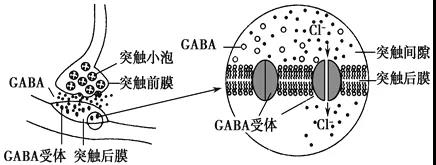 发布时间:2020-04-18
发布时间:2020-04-18
 来源:浩华生物
来源:浩华生物
 浏览量:2376
浏览量:2376
采食是动物维持生存所必需的活动,充足的采食量更是发挥其生产潜力的必要保证。影响采食量的因素有很多,包括环境因素、动物因素、饲料因素等。在生产实践中,饲养动物不可避免的会遭遇饲料更换、冷热刺激、发情期狂躁好斗等因素影响,产生应激反应,从而降低采食影响生产效益。近年来对动物采食量调控的研究越来越受到重视,主要是添加外源添加剂通过神经调节、体液调节等方式来提高采食量。据报道称,γ-氨基丁酸(γ-amino butyric acid,GABA) 具有促进动物采食量、抗应激、镇静等生理功能。
Foraging is a vital activity for animal survival and production. Adequate food intake is necessary to ensure the survival of animals and to better realize their productive potential. There are many factors affecting feed intake, including environmental factors, animal factors, feed factors and so on. In production practice, it is inevitable that feeding animals will suffer from feed change, cold and hot stimulation, manic and aggressive factors in heat, and produce stress response, so as to reduce the influence of food intake on production efficiency. In recent years, more and more attention has been paid to the research on the regulation of feed intake in animals. γ-amino butyric acid (GABA) has been reported to promote physiological functions such as food intake, anti-stress and sedation.
GABA是哺乳动物体内广泛存在的一种抑制性神经递质。近年,学界对饲用GABA在动物饲粮中添加用于对抗应激、提高采食做了大量的研究。
GABA is a widely available inhibitory neurotransmitter in mammals. In recent years, the academic community has done a lot of research on feeding GABA in animal diets to fight stress and improve food intake.
GABA简介及其生理功能
Overview of GABA and its physiological functions
GABA又称氨酪酸,是谷氨酸(Glu)在谷氨酸脱羧酶(GAD)作用下经α-脱羧反应获得的产物。GABA是中枢神经系统中重要的抑制性氨基酸类神经递质,在不同的部位其作用方式不同,在脑中GABA作用方式以突触后抑制为主,而在髓中则以突触前抑制为主。
GABA, also known as aminotyrosine, is the product of glutamic acid (Glu) under the action of glutamic acid decarboxylase (GAD) by the -decarboxylation reaction. GABA is an important inhibitory amino acid neurotransmitter in the central nervous system, and it has different modes of action in different parts. The mode of GABA action in the brain is dominated by post-synaptic inhibition, while that in the medulla is dominated by presynaptic inhibition.

GABA的生理功能主要体现在其对机体正常生理机能的调控上,主要有降血压、镇静神经、延缓细胞衰老、抗应激等作用。此外,GABA对动物采食量也具有明显的调控作用。
The physiological functions of GABA are mainly reflected in its regulation of normal physiological functions of the body, mainly including lowering blood pressure, calming nerves, delaying cell aging and anti-stress. In addition, GABA has an obvious regulatory effect on feed intake in animals.
提高采食的作用机制
Mechanism of improving food intake
目前,对GABA调控采食量的作用机制已有较多报道,下面仅就GABA 调控采食量的3 种最被认可的途径作初步介绍。
The mechanism of GABA regulating feed intake has been widely reported. Now we choose the three most recognized approaches for your information.
1 抑制饱觉中枢
Inhibits satiety centers
饱觉中枢位于下丘脑腹内侧核( VMH),机体通过感应血液和下丘脑中葡萄糖浓度,将信息传递到VMH,再由饱觉神经调节采食。GABA 在VMH中是促进采食的信号分子。当葡萄糖缺乏时,会引起VMH中GABA 浓度升高,从而导致采食增加。
The satiety center is located in the ventromedial hypothalamus nucleus (VMH). The body sends the message to VMH by sensing glucose levels in the blood and hypothalamus, then the satiety nerve regulates feed intake. GABA is a signaling molecule in VMH that promotes feed intake. When glucose is deficient, the concentration of GABA in VMH increases. An increase in GABA concentration leads to an increase in feed intake.
2 通过味觉调控采食
Feed intake is regulated by acting on the taste response
味觉受体细胞(TRCs)有3种亚型,味觉反射是通过3种亚型的味觉细胞间信息传递而发挥功能的,TRCs直接受中枢神经系统支配。研究表明,动物的味蕾细胞内的GABA参与了味觉的调控,并且在动物延髓内侧微注射GABA可使其采食量增加。
There are three subtypes of taste receptor cells (TRCs). The taste reflex functions through inter-cellular communication among the three subtypes of taste. TRCs are directly administered by the central nervous system. Studies have shown that GABA in the cells of animal taste buds is involved in taste regulation, and microinjection of GABA into the medial medulla oblongata of animals can increase feed intake.
3 协同NPY促进采食
Synergies with NPY to promote feed intake
NPY称为神经肽酪氨酸,在中枢神经系统中,NPY具有促进动物采食,影响激素分泌、性行为,体温调节等各种生物功能。促摄食的NPY神经元经过一些列的信号传导,最终抑制交感神经和兴奋副交感神经,引发强列的摄食反应。GABA是NPY增食效应的促进剂,GABA促进NPY的分泌,提高血液中NPY的浓度,进而提高动物采食。
NPY is called neuropeptide tyrosine. In the central nervous system, NPY has various biological functions such as promoting animal feed intake, affecting hormone secretion, sexual behavior, and temperature regulation. NPY neurons go through a series of signal transductions, which eventually inhibit the sympathetic and excitatory parasympathetic nerves, trigger a strong series of ingestion responses. GABA is a promoter of the dietary effect of NPY. GABA promotes the secretion of NPY and increases the concentration of NPY in the blood, which in turn increases the feed intake.
GABA缓解热应激的作用机制
The mechanism of GABA to alleviate heat stress
热应激是指机体应对环境高温所产生的非特异性应答反应。由于全球变暖,热应激渐成为危害畜牧生产的最重要因素之一。热应激会加速体内脂肪、糖原及蛋白质的分解代谢,以致畜禽采食量下降、生长受阻、饲料报酬下降、体重降低。
Heat stress refers to the non-specific response of the body to high temperature. Due to global warming, heat stress is becoming one of the most important factors to harm livestock production. Heat stress will accelerate the catabolism of fat, glycogen and protein in the body, resulting in the decrease of feed intake and feed remuneration.
热应激主要通过2种方式影响畜禽生产性能,一种是激活HPA轴和抑制性神经系统;另一种是降低血浆中2种甲状腺素[三碘甲腺原氨酸(T3)、四碘甲腺原氨酸(T4)]、胰岛素的浓度以及提高皮质酮(CS)浓度来影响营养物质合成代谢过程。
Heat stress mainly affects the performance of livestock and poultry production in two ways. One is to activate the HPA axis and the inhibitory nervous system. The other is to reduce the plasma concentration of two thyroxine [triiodothylamine (T3), tetraiothylamine (T4)]and insulin,but increase the concentration of corticosterone (CS) to affect the process of nutrient anabolism.
.jpeg)
GABA是神经系统中主要的神经拮抗剂,具有抗热应激与镇静等作用。GABA介导大部分中枢神经及外周神经的消极动作。在热应激情况下,饲粮中添加GABA可以显著提高饲养动物的体重、采食量、日增重、胴体重以及血液中T3、胰岛素的浓度,而且可以显著降低血液中CS的浓度,缓解热应激效应。另外,日粮中添加GABA可以提高血清抗氧化指标SOD、GSH-PX的活性,降低反应细胞膜伤害程度的指标MDA的活性,显著降低血清COR、CORT及ACTH三种激素浓度,明显减少机体的热应激反应。
GABA is the main nerve antagonist in the nervous system, which has the effects of heat stress and sedation. GABA mediates the passive action of most central and peripheral nerves. In the case of heat stress, dietary GABA can significantly improve the body weight, feed intake, daily weight gain, carcass weight, and blood T3 and insulin concentration of feed animals, as well as significantly reduce the concentration of CS in the animal blood to alleviate the effect of heat stress. In addition, dietary addition of GABA can improve the activity of serum antioxidant indexes SOD and GSH-PX, reduce the activity of MDA which reflects the damage degree of cell membrane, significantly reduce the concentration of three hormones-COR, CORT and ACTH, and obviously reduce the body's heat stress response.小结 Summary
GABA可以通过抑制饱感神经兴奋、调控味觉反应、促进NPY(增食效应的促进剂)的分泌等方式,提高动物采食量;另外,GABA还能通过抑制中枢神经反应、抑制激素分泌等方式,减少应激反应。因此,在实践生产中,GABA一方面可抑制应激反应、另一方面又能促进采食,从两个维度上完美的解决了生产实践中应激反应对动物采食量的影响,提高生产效益。
GABA can increase feed intake in animals by inhibiting the stimulation of satiety nerve, regulating the taste response, and promoting the secretion of NPY (an accelerant of feeding effect). In addition, GABA can also reduce stress response by inhibiting central nervous system response and hormone secretion. Therefore, in practical production, GABA can not only inhibit the stress response, but also promote feed intake. So that perfectly solved the effect of stress response and improved the production efficiency.
随着夏季和禁止饲添抗生素的日期越来越近,饲养动物必定会面临诸如高湿高热、饲料中无抗生素、环境微生物增多等多种应激,喜食宁(GABA)必将是助您提高生产成绩的较好选择。
With the approaching of the summer and the prohibition of feeding antibiotics, feeding animals are bound to face a variety of stress, such as high humidity and high heat, no antibiotics in the feed, the increase of environmental microorganisms, and so on. GABA will be the best choice for you to improve the production efficiency.
应用方案
Application solutions
.jpeg)
参考文献:
3.施忠秋, 齐智利.γ-氨基丁酸调控采食量和缓解热应激的机制.动物营养学报, 2014(1):49-53.
4.Y. Cao, F.-l. Zhao, T. Kolli, etc. GABA expression in the mammalian taste bud functions as a route of inhibitory cell-to-cell communication.The Physiological Society.2004:4006-4011.